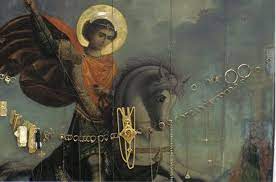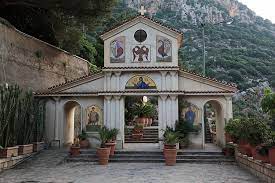The Holy Monastery of Agios Georgios Gorgolainis is located at an altitude of 500 meters near the village of Kato Asites, where it belongs, and it was the one that survived more than the rest of the monasteries in the area, during the various revolutions during the Turkish occupation.


Until the beginning of the 20th century, the monastery had valuable property, such as the old Monastery of Chrysopigi in Pyrgos and the monastery of Agios Antonios in Petali Sarchos. Today, the monastery is home to the Ecclesiastical Home Economics School.


In the precincts of Monastery Agios Georgios, one can see the bust of the brave chieftain Fragias Mastrachas, who was killed by the Turks at the age of 75, in 1868 in a battle in Asites village. Also, in the fountain of the monastery there was a marble lion, from the time of the Venetian occupation, but it was stolen in 1990. It is even said that the name Gorgolaini comes from the rapid filling of the latrines.
Huge oak trees covering a large part of the grounds (two of these trees, the sycamore and the cypress, have been declared “preservable monuments of nature”). In 2001, 1 person was registered in the Monastery. The monastery was renovated in 1950.
Historical data-Monastery Agios Georgios
Gorgolaini played an important role in stimulating the religious and national sentiment of the Assitians and not only during the period of the Turkish occupation. It is an important monastery that has existed at least since the years of the Venetian occupation. The oldest mention of it dates back to the 13th century. Its founder is said to be archpriest Silvestros. The catholicon is dedicated to Saint George whose church was completed in 1627.
During the period of the Turkish occupation, Monastery Agios Georgios was a center of revolutionary movements due to its location and was set on fire by the Turks. In August 1822, a battle took place in the monastery between 5,000 rebels and 22,000 Turks. In 1830 it was rebuilt by the abbot Methodios and the monk Neophytos. In 1866, an assembly of revolutionaries was convened there by Michael Korakas. The Turks were informed of the event and launched an attack, but were repulsed by the rebels and fled. In 1867, after a bloody battle, the fighters were defeated and Korakas was forced to leave the monastery. During that period, the chief Mastrachas was also killed.
Best time to visit Monastery Agios Georgios
Asites village is a place you can visit all year round, it is very close to Heraklion city, place where beautiful surroundings attract visitors. Hiring a car is the best way to travel to the place, visit the village and of course the Monastery Agios Georgios – Gorgolainis, feel the holy atmosphere of the place and dicover your feelings! Best time to visit the Monastery Agios Georgios is all year round, avoid early morning hours as Monks pray and work.
How to get to Monastery Agios Georgios
By car
Visiting Monastery Agios Georgios is a must when visiting island of Crete. Hiring a car is an easy way to visit Asites village and the Monastery. Collect your car and drive to the village, there is an easy sign to get to the Monastery Agios Georgios Gorgolainis.
By taxi
From Heraklion airport Taxi is a good solution, estimate an approximate cost of 45eur. The driver will drive straight out of the Monastery entrance, a good way to get transferred there.
By bus
You will need to get the bust driving to Asites, as soon as you drive there- find the junction to walk the distaance to the Monastery, this solution iss not recommended as you may need to walk a long distace, especially iif yu drive there for the first time.
